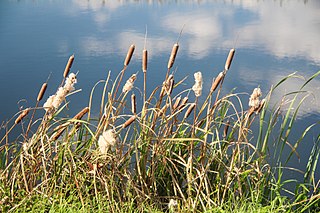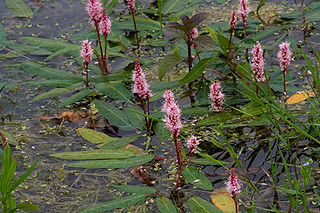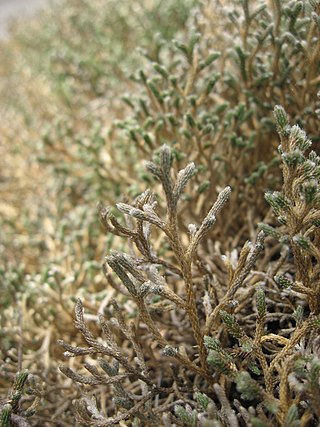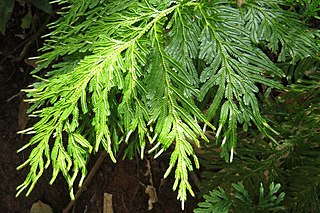
Selaginella is the sole genus in the family Selaginellaceae, the spikemosses or lesser clubmosses, a kind of vascular plant.

Spanish moss is an epiphytic flowering plant that often grows upon large trees in tropical and subtropical climates. It is native to much of Mexico, Bermuda, the Bahamas, Central America, South America, the Southern United States, and West Indies. It has been naturalized in Queensland (Australia). It is known as "grandpa's beard" in French Polynesia.

Typha latifolia, better known as broadleaf cattail, is a perennial herbaceous plant in the genus Typha. It is found as a native plant species in North and South America, Eurasia, and Africa.

Vitis rupestris is a species of grape native to the United States that is known by many common names including July, Coon, sand, sugar, beach, bush, currant, ingar, rock, and mountain grape. It is used for breeding several French-American hybrids as well as many root stocks.

Myriophyllum spicatum is native to Europe, Asia, and north Africa, but has a wide geographic and climatic distribution among some 57 countries, extending from northern Canada to South Africa. It is a submerged aquatic plant, grows in still or slow-moving water, and is considered to be a highly invasive species.

Selaginella lepidophylla is a species of desert plant in the spikemoss family (Selaginellaceae). Known as a "resurrection plant", S. lepidophylla is renowned for its ability to survive almost complete desiccation. Resurrection plants are vascular rooted plants capable of surviving extreme desiccation, then resuming normal metabolic activity upon rehydration. The plant's hydro-responsive movements are governed by stem moisture content, tissue properties and a graded distribution of lignified cells affecting concentric stem stiffness and spiraling. During dry weather in its native habitat, its stems curl into a tight ball, uncurling only when exposed to moisture.

Selaginella apoda, commonly known as meadow spikemoss, is a perennial lycophyte native to much of the eastern United States and parts of northeastern Mexico. The life cycle is the shortest of the genus Selaginella, as well as one of the shortest among the lycophytes. Selaginella apoda is found primarily in damp soils in habitats such as swamps, wet fields, open woods and along stream banks. Selaginella apoda presents the potential for case studies involving the plant's adaptability to environmental toxins. A lowland plant, it has only been recorded at elevations below 100 meters. It is closely related to Selaginella eclipes and S. ludoviciana, with both of which it has been reported to form hybrids. This group is characterized by relatively flat strobili and large megasporophylls which occur in the same plane as the lateral leaves.

Selaginella selaginoides is a non-flowering plant of the spikemoss genus Selaginella with a wide distribution around the Northern Hemisphere. It resembles a moss in appearance but is a vascular plant belonging to the division Lycopodiophyta. It has a number of common names including lesser clubmoss, club spikemoss, northern spikemoss, low spikemoss and prickly mountain-moss. This plant has one close relative, Selaginella deflexa, native to Hawaii. These two plants form a small clade that is sister to all other Selaginella species.

Selaginella kraussiana is a species of vascular plant in the family Selaginellaceae. It is referred to by the common names Krauss' spikemoss, Krauss's clubmoss, or African clubmoss, and is found naturally in parts of Sub-Saharan Africa and in Macaronesia. It is sometimes given the misnomer of “peacock fern”, due to its lacy leaf structure, despite having no relation to actual ferns; rather, it belongs to the very ancient lineage of plants known as the clubmosses.

Carex pensylvanica is a species of flowering plant in the sedge family commonly called Pennsylvania sedge. Other common names include early sedge, common oak sedge, and yellow sedge.

Lycopodiella inundata is a species of club moss known by the common names inundated club moss, marsh clubmoss and northern bog club moss. It has a circumpolar and circumboreal distribution, occurring throughout the northern Northern Hemisphere from the Arctic to montane temperate regions in Eurasia and North America. It grows in wet habitat, such as bogs, ponds, moist spots on the tundra, and long-standing borrow pits.

Persicaria amphibia is a species of flowering plant in the knotweed family known by several common names, including longroot smartweed, water knotweed, water smartweed, and amphibious bistort. It is native to much of North America, Asia, Europe, and parts of Africa, and it grows elsewhere as an introduced species and sometimes a noxious weed.

Selaginella uncinata, the blue spikemoss, peacock moss, peacock spikemoss, or spring blue spikemoss, is a species of plant in the Selaginellaceae family.

Selaginella densa is a species of spikemoss known by the common names lesser spikemoss, prairie spikemoss, and Rocky Mountains spikemoss. It is native to western North America, where it can be found from Alaska to Ontario, the Dakotas, Texas and far northern California.

Selaginella oregana is a species of spikemoss known by the common name Oregon spikemoss. It is native to the Pacific Coast of western North America, where it can be found from British Columbia to northern California. It grows in mossy, shady coastal forests. It is often epiphytic, growing attached to tree branches, its stems hanging in sheets of green, mosslike streamers. Trees commonly occupied by the spikemoss include bigleaf maple, black cottonwood, and red alder. It also grows on the ground and on rocks in carpetlike mats. This lycophyte has creeping or hanging stems up to about 60 centimeters long, usually with forking branches. They curl as they dry. The stems are radially symmetric, with spirals of lance-shaped leaves each measuring 2 or 3 millimeters in length and tipped with a tiny, rigid bristle. The strobili containing the reproductive structures are up to 6 centimeters long and often occur in pairs.

Echinocereus viridiflorus is a species of cactus known by the common names nylon hedgehog cactus, green pitaya, and small-flowered hedgehog cactus. It is native to the central and south-central United States and northern Mexico, where it can be found in varied habitat types, including desert scrub, woodlands, dry grasslands, and short-grass prairie.
Selaginella stellata, also recognized by its common name, starry spikemoss or starry spike-moss, is a species of spikemoss of the family Selaginellaceae. It is a type of lycopod that grows naturally in Mexico and Central American countries like Guatemala and Belize and can also be found in the state of Hawaii.

Selaginella tortipila is a species of clubmoss in the family Selaginellaceae. It is referred to by the common names twistedhair spikemoss or kinky-hair spike-moss, and is a member of an early diverging group of plants. It is native to the Southeastern United States where it is found in a small area in the Southern Appalachian Mountains and Piedmont. It is found on granite or sandstone rock outcrop communities, often at high elevation.
Solidago rupestris , the rock goldenrod or riverbank goldenrod, is a North American species of flowering plants in the family Asteraceae. It is found in the eastern United States, found today in the States of Maryland, Virginia, Kentucky, and Tennessee. There are historical records of it formerly growing in Indiana and Pennsylvania as well, but these populations now appear to have been extirpated.

Selaginella longipinna, commonly known as the electric fern, is a plant in the spike moss family Selaginellaceae. It is endemic to northeastern Queensland, growing in rainforest and closed forest from Cooktown to near Mission Beach, including the Atherton Tablelands. It is a terrestrial plant forming a dense cover to 40 cm (16 in) high, often near streams.


















